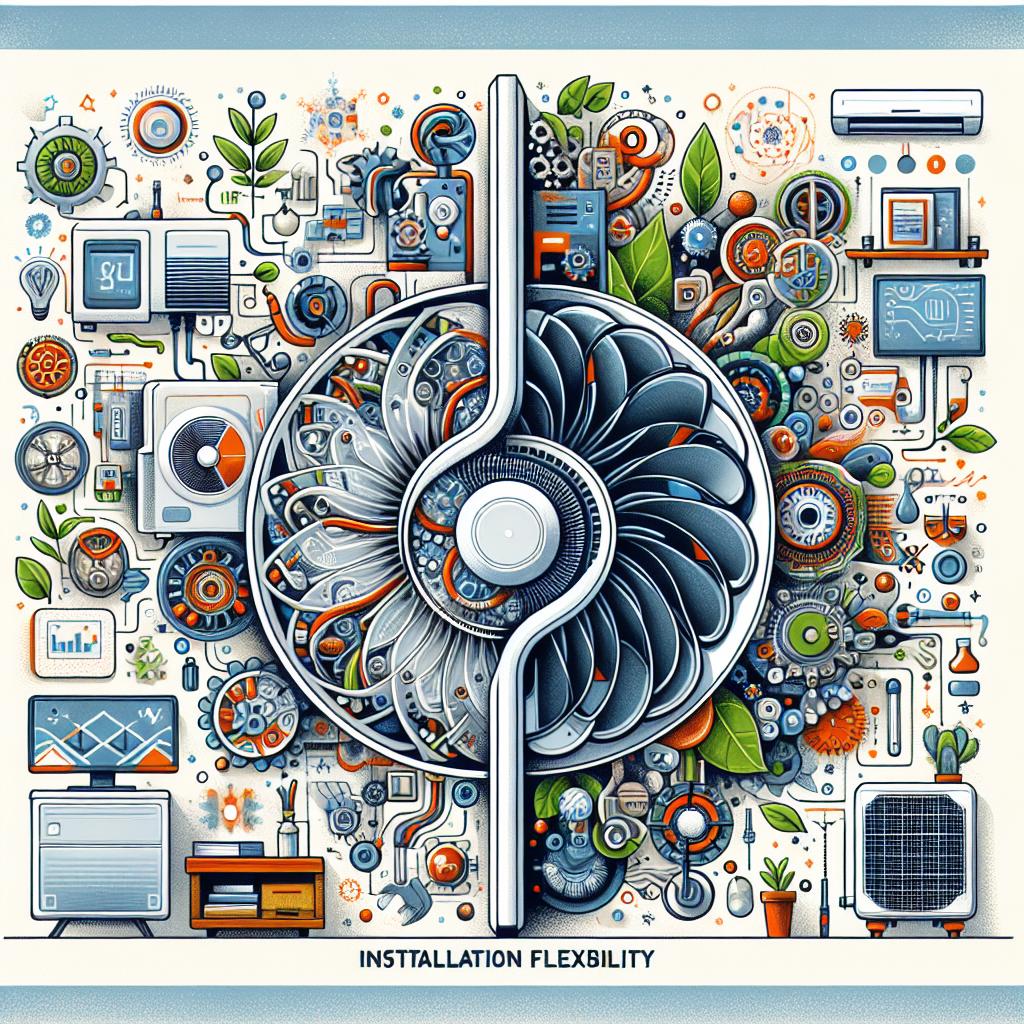In the sweltering heat of summer or the unbearable humidity of early fall, maintaining a comfortable environment in commercial spaces is not just a luxury—it’s a necessity. As businesses strive to create inviting atmospheres for customers and productivity-enhancing conditions for employees, the choice of cooling systems becomes paramount. Among the myriad of options available, mini split air conditioning systems have gained significant attention for their flexibility and efficiency. But how do they stack up against more traditional cooling solutions, such as central air systems or window units? In this article, we’ll explore the nuances of various cooling technologies, spotlighting the advantages and drawbacks of mini splits in comparison to their counterparts. Whether you’re a business owner looking to optimize your cooling strategy or simply curious about your options, join us as we dive into the complexities of climate control in commercial settings.
Evaluating Energy Efficiency and Cost of Operation in Cooling Systems
When assessing the energy efficiency and operating costs of different cooling systems, mini-split air conditioning units shine with their innovative design and performance qualifications. Unlike traditional centralized systems that can waste energy by cooling unoccupied spaces, mini-splits allow for precise temperature control, enabling businesses to target specific areas or zones. This feature not only enhances comfort but also reduces energy consumption. Additionally, many models come with variable-speed compressors that adjust their output according to the cooling demand, leading to significant savings in electricity bills over time. The benefits can be summarized as follows:
- Energy Savings: Lower operational costs due to targeted cooling.
- Advanced Technology: Features like inverter technology for enhanced efficiency.
- Minimal Duct Losses: Direct cooling eliminates energy loss common in duct systems.
In contrast, other cooling solutions such as traditional central air conditioning or window units can present various challenges in both energy efficiency and affordability. Central systems often result in higher costs due to their extensive infrastructure and maintenance requirements, while window units can lack the capability to cover large commercial spaces effectively. Evaluating these alternatives reveals critical differences, highlighted in the table below:
| Cooling Solution | Energy Efficiency Rating | Average Cost (Installation + Operation) |
|---|---|---|
| Mini Split AC | High (SEER 16+ | Moderate |
| Central AC | Moderate (SEER 14-16) | High |
| Window Unit | Low to Moderate (SEER 10-14) | Low |
This comparative analysis highlights that while mini-split models may have a higher upfront cost, their long-term efficiency and reduced operational expenses counterbalance the initial investment. On balance, businesses seeking reliable and cost-effective cooling solutions should seriously consider the advantages of mini-split systems over more traditional methods.

Understanding Installation Flexibility: Mini Split AC vs. Traditional Units
When it comes to cooling solutions for commercial spaces, the installation flexibility offered by mini split systems significantly outshines traditional air conditioning units. Mini split ACs consist of two primary components: an indoor air handler and an outdoor compressor. This design eliminates the need for extensive ductwork, allowing for a multitude of placement options. As a result, businesses can tailor the installation to fit their unique architectural layouts without compromising aesthetics. The simplicity of mounting the indoor units on walls or ceilings grants business owners creative freedom and minimizes disruption during installation.
In contrast, traditional units often require extensive duct installations that can be both time-consuming and costly. The rigid nature of these systems leads to limitations on where they can be installed, which can pose challenges in older buildings or in spaces with irregular layouts. While traditional units are effective in their cooling capabilities, their lack of flexible installation options can increase operational downtime and inconvenience. By choosing mini split ACs, businesses not only enjoy efficient cooling but also reap the benefits of less intrusive implementation. Consider the following key advantages of mini split installations:
- Increased Placement Options: Perfect for varying architectural styles.
- Less Disruption: Quick and efficient installation processes.
- Aesthetic Integration: Indoor units can complement any decor.

Assessing Performance in Diverse Commercial Environments
When evaluating the performance of mini split AC systems compared to traditional cooling solutions like central air conditioning and portable units, several factors must be taken into account. Energy efficiency emerges as a crucial criterion. Mini split systems typically boast higher Seasonal Energy Efficiency Ratios (SEER), translating to significant savings on energy bills over time. Furthermore, the flexibility of their installation allows for targeted cooling, enhancing comfort levels in specific areas without unnecessarily overcooling the entire building.
Another vital aspect is maintenance requirements. Mini split systems generally require less upkeep than traditional units because they don’t have ducts that can accumulate dust and allergens. This often results in improved air quality within commercial spaces. Additionally, when comparing noise levels, mini splits operate at lower decibels than standard HVAC systems, creating a quieter environment conducive to both employee productivity and customer satisfaction. To illustrate this further, consider the following comparison table:
| Cooling System | Energy Efficiency (SEER) | Maintenance Needs | Noise Level (dB) |
|---|---|---|---|
| Mini Split AC | 18-30 | Low | 19-50 |
| Central AC | 13-20 | Moderate | 70-80 |
| Portable AC | 10-14 | High | 50-60 |

Exploring Maintenance Needs and Long-Term Reliability of Cooling Solutions
When considering the long-term viability of cooling solutions for commercial spaces, maintenance requirements play a crucial role. Mini split AC systems are gaining traction due to their flexibility and efficiency, but they still necessitate regular upkeep to ensure peak performance. Key aspects of maintenance include:
- Filter Cleaning: Regularly cleaning or replacing filters is essential to maintain air quality and system efficiency.
- Indoor & Outdoor Unit Inspection: Periodic checks can prevent minor issues from escalating into costly repairs.
- Refrigerant Levels: Ensuring proper refrigerant levels is critical for efficient cooling and energy savings.
In comparison, traditional cooling solutions like centralized HVAC systems generally demand more intensive maintenance efforts. The complexity of ductwork and the need for extensive inspections can lead to increased operational downtime. Here’s a quick comparison of maintenance interval and reliability:
| Cooling Solution | Maintenance Frequency | Typical Lifespan |
|---|---|---|
| Mini Split AC | Every 6-12 months | 15-20 years |
| Central HVAC | Every 3-6 months | 10-15 years |
| Window Units | Seasonally | 5-10 years |
Ultimately, selecting a cooling solution with manageable maintenance needs and dependable reliability can lead to significant cost savings and enhanced comfort over time. By investing in a mini split system, businesses can benefit from reduced maintenance hassle while enjoying consistent and efficient temperature control.
Q&A
Q&A: Comparing Mini Split AC with Other Cooling Solutions for Commercial Spaces
Q1: What is a mini split AC system, and how does it differ from traditional cooling systems?
A1: A mini split AC system consists of two main components: an outdoor compressor and one or more indoor air handlers. Unlike traditional HVAC systems that rely on ductwork to distribute cool air, mini splits are ductless, allowing for targeted cooling in specific zones. This design not only saves on installation costs but also offers increased energy efficiency, as you can cool only the areas in use.
Q2: What are the advantages of using mini split systems in commercial spaces?
A2: Mini split systems provide several benefits for commercial spaces. They are energy-efficient, which can lead to substantial savings on utility bills. Their ductless design allows for flexible installation in spaces where ductwork is impractical. Additionally, mini splits offer customizable zoning, so different areas can be cooled to the desired temperatures, enhancing comfort for employees and customers alike.
Q3: How do mini split systems compare to rooftop units (RTUs)?
A3: Rooftop units are commonly used for larger commercial buildings and can handle a significant cooling load across vast areas. However, they require extensive ductwork, which can be costly to install and maintain. In contrast, mini splits offer a more compact solution and avoid the ductwork dilemma, making them ideal for smaller spaces or buildings undergoing renovation. However, for larger operations, RTUs may be more effective due to their capacity.
Q4: Are mini splits more cost-effective than window units for commercial use?
A4: While window units may have lower upfront costs, they lack energy efficiency and the ability to provide consistent cooling over larger areas. Window units can also pose security risks and can be less aesthetically pleasing. Mini splits may have a higher initial investment, but their energy efficiency, noise reduction, and zoning capabilities often result in greater long-term savings and overall benefits for commercial environments.
Q5: What considerations should businesses keep in mind when choosing between mini splits and other cooling solutions?
A5: Businesses should evaluate factors such as space layout, cooling needs, budget constraints, and the need for zoning. For instance, if a space has multiple rooms with varying temperature preferences, mini splits might be the way to go. Also, consider the potential for future expansion—if the business grows, mini splits can easily be added without extensive reconfiguration.
Q6: Can mini split systems provide both heating and cooling?
A6: Yes! Many mini split systems come with a heat pump feature, allowing them to provide both heating and cooling while maintaining efficiency throughout the year. This dual functionality can be particularly beneficial in regions with temperature fluctuations, as it eliminates the need for separate heating and cooling systems.
Q7: What about maintenance—how does it compare to other cooling solutions?
A7: Mini split systems generally require less maintenance compared to traditional ducted systems because there are fewer components prone to wear. Cleaning filters and periodic inspections are usually sufficient for power and efficiency upkeep. In contrast, HVAC systems with extensive ductwork require regular cleaning and servicing to prevent dust build-up and ensure optimal performance.
Q8: Are there any downsides to using mini split systems in commercial settings?
A8: While mini splits are efficient and flexible, they do come with a few potential drawbacks. The initial costs can be higher than window units, and installing multiple indoor units could clutter spaces. Additionally, they may not have the cooling capacity of larger commercial systems, which means they might not be suitable for very large facilities.
Q9: when should businesses consider opting for a mini split AC system over other cooling solutions?
A9: Businesses should consider mini split systems when looking for an energy-efficient, customizable cooling solution that can easily adapt to various spaces. If the goal is to enhance comfort in specific zones or if ductwork is limited or absent, mini splits can be the ideal choice. Ultimately, it’s about aligning the cooling solution with the unique needs of the commercial space.
Future Outlook
As the sweltering heat of summer approaches, the quest for an efficient and effective cooling solution becomes paramount for commercial spaces. In weighing the advantages of mini split AC systems against traditional cooling methods, one thing remains clear: there is no one-size-fits-all answer. Each option brings its own set of benefits and drawbacks, reflecting the diverse needs of businesses.
the best choice hinges on factors such as space configuration, energy efficiency, budget constraints, and specific cooling requirements. Mini split systems shine in their ability to offer customizable comfort, whisper-quiet operation, and significant energy savings, making them an attractive option for many commercial environments. Conversely, traditional systems may still hold a place for larger facilities with distinct cooling demands.
As you navigate the landscape of cooling solutions, consider the unique characteristics of your space and how each system aligns with your goals. Your ideal cooling strategy is out there; it’s merely a matter of matching the right solution to your commercial needs. With careful thought and consideration, you can create a comfortable environment that not only survives the heat but thrives in it. Happy cooling!

